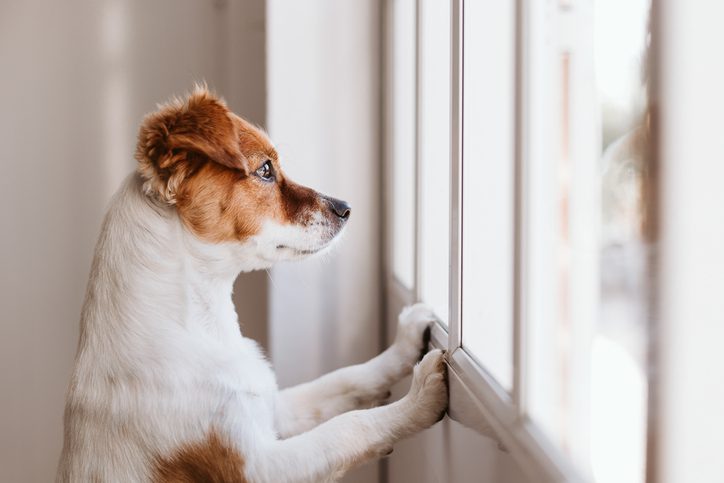Dog Separation Anxiety in Limerick, PA: What it is and How it Affects Your Pet
Dogs are a big part of our lives, but we are an even more significant part of theirs. Dogs live their whole lives to make people happy, which can lead to separation anxiety in some animals. You might have a dog that gets upset when you leave home, and you might be worried about how to help them feel better when you are gone.
If your dog is anxious when you leave, you might not realize how it affects them. You might know your dog is worried or nervous, but you might not realize just how tough this behavioral pattern is on your dog.
If you are ready to learn more about dog separation anxiety and how it affects your pet, read on!

What is Dog Separation Anxiety?
Dog separation anxiety happens when a dog cannot find comfort when left alone at home or in their yard. This anxiety might show up in the form of digging, chewing, barking, or even marking behaviors and self-harm.
Certain dog breeds might be more likely to exhibit this behavior. However, each pet has their unique life history and personality that can impact the development of this kind of behavior. Dogs that have been mistreated or that are not given the right living conditions can also display this behavior. In some cases, older dogs might also exhibit this behavior.
Symptoms of Dog Separation Anxiety
Dog separation anxiety can be expressed through a wide array of symptoms. Not every dog shows the same combination of symptoms. However, these are the most common behaviors that can be connected with anxiety in dogs.
- Urinating or defecating in the house
- Aggression
- Panting
- Pacing
- Destructive behavior
- Repetitive behaviors
- Restlessness
- Depression
- Self-harm
- Drooling
These symptoms might also change over time. Your dog could start out showing one symptom and start displaying more over time. Your dog might also experience a period where they don’t show signs of anxiety and periods where their anxiety is intense.
Sometimes separation anxiety can be related to fear or an event that caused your dog significant stress. Suppose your dog has always been really attached to you. In that case, your dog’s separation anxiety might only be related to the fact that you have left the house.
How Does Dog Separation Anxiety Affect Your Dog?
Anxiety in dogs can lead to many negative behaviors that can damage your home or yard, or they might even hurt themselves. Dogs that are anxious can pull out their hair or injure their feet by digging or pacing.
Dogs that suffer from extreme separation anxiety can have lots of health problems. They might also struggle to cope with life even when you are home. Separation anxiety can be very hard on your dog, both physically and mentally. Your dog’s anxiety might also cause issues for other pets in the home or for your goals to teach them new skills.
Why Is My Dog Showing These Symptoms?
A lot of different stimuli can cause these kinds of issues. Your dog might be scared of thunderstorms, or they might have been left alone for a long time in a crate as a puppy without attention. Maybe your dog is not getting enough exercise, which is the reason for their anxiety.
The most common reason dogs show these symptoms is how dog social structures work. Dogs are pack animals, and they are inclined to want to live in groups. This is often the root cause of your dog’s anxiety when you leave the house. It might seem like it will be impossible to help your dog overcome this behavior. Thankfully, there are some ways to help your dog overcome this behavioral pattern.
How to Help Your Dog Overcome Separation Anxiety
Along with talking with your veterinarian, these 4 tips can help your dog and their separation anxiety.
1. Create a Routine
You need to ensure that your dog knows what to expect from their days. Your dog will feel safer and more secure when you create a routine. Pack behavior is based on predictable patterns. You will appeal to your dog’s innate senses when you make a solid routine for them.
2. Make Sure Your Dog Has What They Need
Your dog needs exercise, and they need the proper stimulation each day as well. You should be sure that you walk your dog or play with them, and you should make sure that you offer them chew toys and other entertainment. When you are gone, you should leave some toys with your dog to help them pass the time doing something besides destroying furniture or getting upset.
3. Train Relaxation
You will need to build a relaxation cue into your training plans. When you are fetching with your dog, walking them, or engaging in other activities, you will need to also work on a laydown cue or a stay cue. This cue can help your dog start out in a calm mental space when you leave each day. This will set the tone for your hours apart.
4. Consider a Kennel
Some dogs feel more safe and secure when they are in a kennel while you are away. This is a space that reminds them of climbing into a den, and for many anxious dogs, it makes a safe space. Ensure that the kennel you get is the right size for your pet, and consider covering the front of the kennel with a blanket or towel while you are away.
Helping Your Dog Overcome Anxiety Can Change Their Life
If your dog is anxious every time you leave, you need to consider helping them to overcome this behavior. Even if your dog is not damaging your home or pulling out their own hair when you leave, the anxiety that they feel when you are away can be bad for their health. Separation anxiety can be very damaging to your pet’s health, and you should take resolving this problem very seriously.
Call (610) 489-2848 or use the online form to book an appointment with your Limerick Veterinary Hospital veterinarian about your dog’s separation anxiety.
